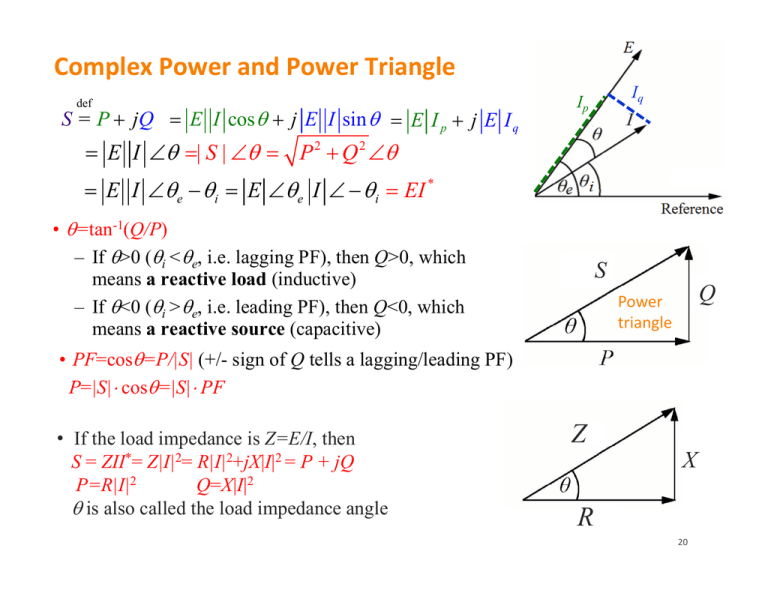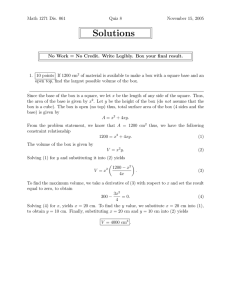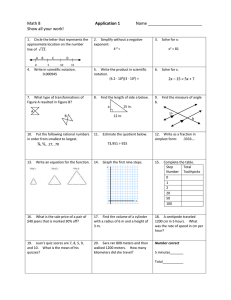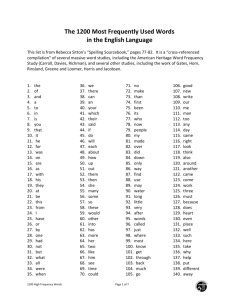Complex Power and Power Triangle R Z
advertisement

Complex Power and Power Triangle def S = P jQ E I cos j E I sin E I p j E I q Iq Ip E I | S | P 2 Q 2 E I e i E e I i EI * • =tan-1(Q/P) – If >0 (i <e, i.e. lagging PF), then Q>0, which means a reactive load (inductive) – If <0 (i >e, i.e. leading PF), then Q<0, which means a reactive source (capacitive) S Q Power triangle • PF=cos=P/|S| (+/- sign of Q tells a lagging/leading PF) P=|S| cos=|S| PF • If the load impedance is Z=E/I, then S = ZII*= Z|I|2= R|I|2+jX|I|2 = P + jQ Q=X|I|2 P=R|I|2 is also called the load impedance angle Z X R 20 Other Useful Formulas * E 2 2 E S Z * 2 |I| S EE S EI * * Z Z II * Z | I |2 Z * • If Z is purely resistive • If Z is purely reactive E P R 2 2 2 2 E E E or Q L 1/ C X 21 Theorem of Conservation of Complex Power • For a power network supplied by independent sources all at the same frequency (all voltages and currents are assumed to be sinusoids), the sum of the complex power supplied by the independent sources equals the sum of the complex power received by all the other branches of the network (SG of all actual sources)=(SL of all the others) • In other words, the total complex power supplied (received) by all branches is zero (SG of all braches)=0 or (SL of all braches)=0 – For a single source with elements in series or parallel, it is proved by Kirchhoff’s voltage or current law (KVL/KCL) – For a general case, it is proved by Tellegen’s theorem. – Application of the theorem: any part of the power network can be replaced by an equivalent independent source 22 • Two examples from A. Bergen and V. Vittal, Power System Analysis, Prentice Hall, 2000 23 24 Examples 7‐2 & 7‐3 25 Example 2.2 on Saadat’s book V 12000 V, Z1 60 j 0, Z 2 6 j12, Z 3 30 j 30 Find the power absorbed by each load and the total complex power I1 V 12000 1200 20 j 0 A Z1 60 j 0 60 V 12000 200 200(1 j 2) 40 j80 A I2 Z2 6 j12 1 j 2 5 I3 S2 V 12000 40 40(1 j ) 20 j 20 A Z 3 30 j 30 1 j 2 S3 S S1 VI1* 12000(20 j 0) 24, 000 W+j 0 var S2 VI 2* 12000(40 j80) 48, 000 W+j 96, 000 var S3 VI 12000(20 j 20) 24, 000 W j 24, 000 var * 3 S1 S S1 S2 S3 96, 000 W+j 72, 000 var 26 • Other approaches I I1 I 2 I 3 (20 j 0) (40 j80) (20 j 20) 80 j 60 100 36.87 A S VI * (12000)(10036.87) 120, 00036.87 VA 96, 000 W j 72, 000 var or Z / / Z1 / / Z 2 / / Z 3 S V 2 Z / /* 1 9.6 j 7.2 1 / Z1 1 / Z 2 1 / Z 3 (1200) 2 96, 000 W j 72, 000 var 9.6 j 7.2 2 V (1200) 2 24, 000 W j 0 var S1 * Z1 60 2 V (1200) 2 48, 000 W j 96, 000 var S2 * Z2 6 j12 2 V (1200) 2 S3 * 24, 000 W j 24, 000 var Z3 30 j 30 27




